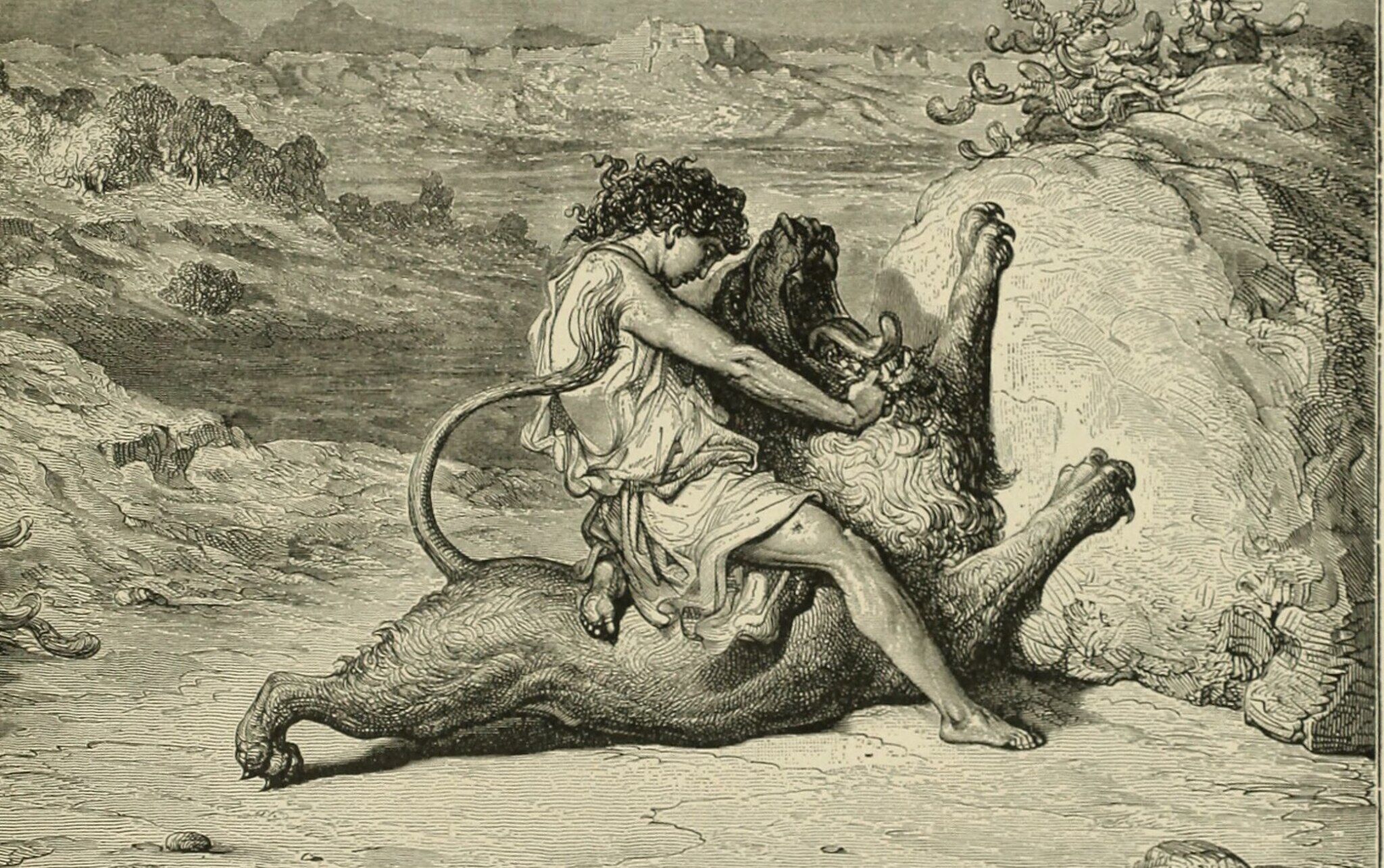Who comes to mind as the most legendary strongman of antiquity? Probably two names: Hercules, of classical Greek lore (where he is actually named Heracles—Hercules is the later Roman form), and the mighty biblical warrior Samson. Through their respective texts, these two individuals of renown have been immortalized to our present day as two of the mightiest men of antiquity (or mythology).
But these two did not simply parallel one another in strength. In fact, uncanny parallels run right through the lives of these two individuals—in deeds, period and even ancestry.
This begs the question: Was Hercules Samson? Or vice versa?
Similarities in Deed
Recognition of such parallels between these two Mediterranean heroes, both divinely imbued with strength, is nothing new. In 1963, it was taken to its perhaps cheesiest extent with Pietro Francisci’s epic (but now rather cringeworthy) Italian film Ercole sfida Sansone (“Hercules challenges Samson,” trailer below—English title Hercules, Samson and Ulysses), whose plot features Hercules and Samson being confused for one another by their deeds before they agree to join forces to fight against the Philistines.
But such “confusion” of deeds for Samson and Hercules, while an intentional storyline for this movie, could be forgiven for the actual historical/mythological individuals themselves. Consider the following rather remarkable parallels between the ancient accounts—Samson, contained within the book of Judges (chapters 13-16); Hercules, within the works of such authors as Homer (eighth century b.c.e.), Sophocles (fifth century b.c.e.), Euripides (fifth century b.c.e.), and innumerable other later sources:
- Both men are divinely imbued with strength
- Both killed a lion with their bare hands as their first main feat, or “labor,” of strength
- Both were responsible for the death of their first wives in a fire
- Both single-handedly wiped out entire armies
- Both faced off against an enemy that fielded giants in their armies
- Both are known for their signature use of clubs as weapons
- Both are associated with “two-headed” canines (Hercules, with the two-headed dog Orthus; Samson, who tied jackals together in twos in a plot against the Philistines)
- Both drank water that miraculously came from a rock
- Both tore down the gates of a city
- Both had a repetitive weakness for women
- Both were sentenced to slavery by or at the hand of a woman
- Both unwittingly met their ultimate demise at the hands of a lover identified as a “man-destroyer” who betrayed them (Samson by Delilah, Hercules by Deanirah)
The list could go on. Could all these be merely coincidental? Some, perhaps—but all?

Differences in Depth
Yet there is, of course, particular difference between the two accounts. Gary G. Cohen summed it up well in his 1970 Evangelical Quarterly article, “Samson and Hercules: A Comparison Between the Feats of Samson and the Labours of Hercules”:
The deeds of the Hercules story, or stories, are completely in the fabulous realm. They are super-human, arbitrary and fantastic. Whatever the man behind the legends did, if such a one lived, the Hercules who has come to our generation is a fabulous character who conquers fabulous beasts by fabulous methods. … It is a wild and fabulous tale which is both interesting and amusing; it is excellent fiction!
On the flipside, with Samson:
On the other hand the account of Samson is portrayed in the Bible in the light of a man given power and duty from the holy God. True, he is aided by supernatural power and he is angelically announced before his birth, but in the Biblical Christian conservative framework this is seen to be the sober truth, for the God of miracles does exist. … Samson’s feats are astounding, but never fabulous. His strength is colossal, but it is human strength aided by the God of all-power.
Indeed, the accounts surrounding the life of Hercules/Heracles are in the realm of fantastical fiction, in no sense believable. In one of his labors, he defeats a nine-headed serpentine monster, for whom every time a head is severed, two more grow in its place. In another labor, he captures the herd of the three-headed, six-armed giant Geryon. In another, he defeats a hundred-headed dragon guarding a tree of golden apples (although, here there is an uncanny underlying core resemblant of Genesis 3). In another labor, Hercules makes a deal with Hades to retrieve a three-headed dog from the underworld.
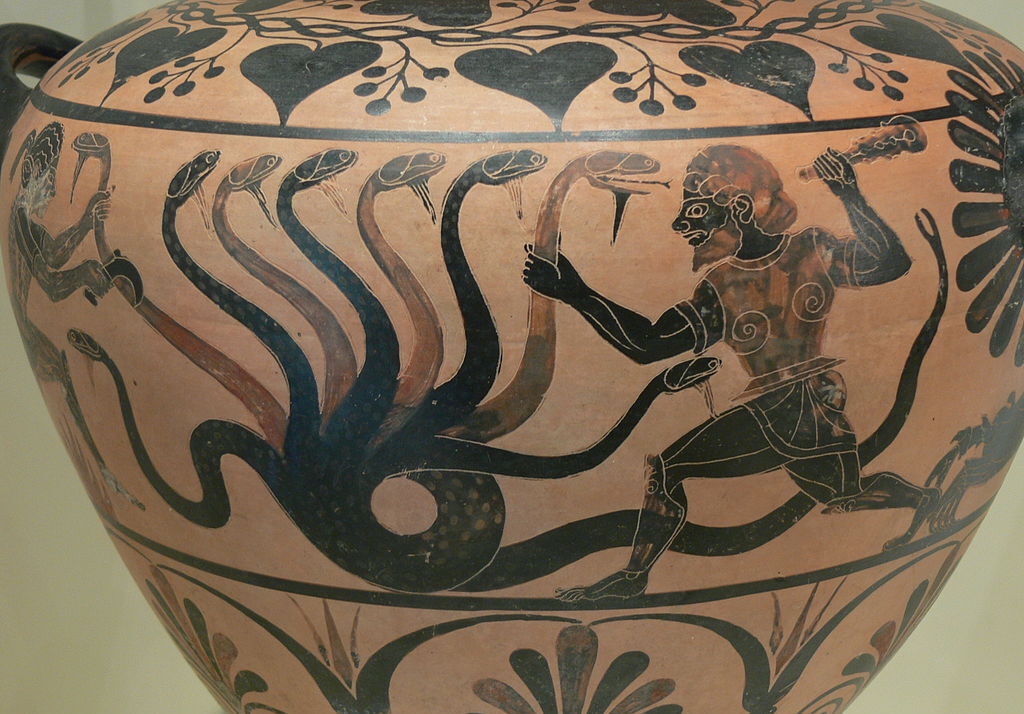
Clearly, a bulk of Hercules’ feats are in the realm of ludicrous fiction. Yet even the most unlikely legends do not typically form out of a complete vacuum. As such, numerous researchers have postulated a core historicity to the legend of the strongman Hercules.
And there is no more tantalizing connection, with such an array of parallels, as that of the biblical Samson. Naturally, the more “believable” nature and presentation of the Samson account on its own favors this as the originating core model on which later Herculean legend was built and over-extrapolated. But more on that further down.

Beyond comparison of the simple acts of the two men—slaying a lion with their bare hands, conquering armies single-handedly, being brought to their demise by the lure of a woman, even each accomplishing 12 “feats,” or labors (in the case of Samson, 12 feats are posited by commentators Ewald and Meier)—remarkable parallels can also be found in period, setting and ancestry.
The Broader Picture
According to biblical chronology, the strongman Samson was on the scene sometime around 1100 b.c.e. He was notably a biblical judge of the tribe of Dan. This tribe was divided into two main territories: one on the Mediterranean coast, bordering the Philistines (from which territory Samson hailed—see map below); and one inland, on Israel’s northern border.
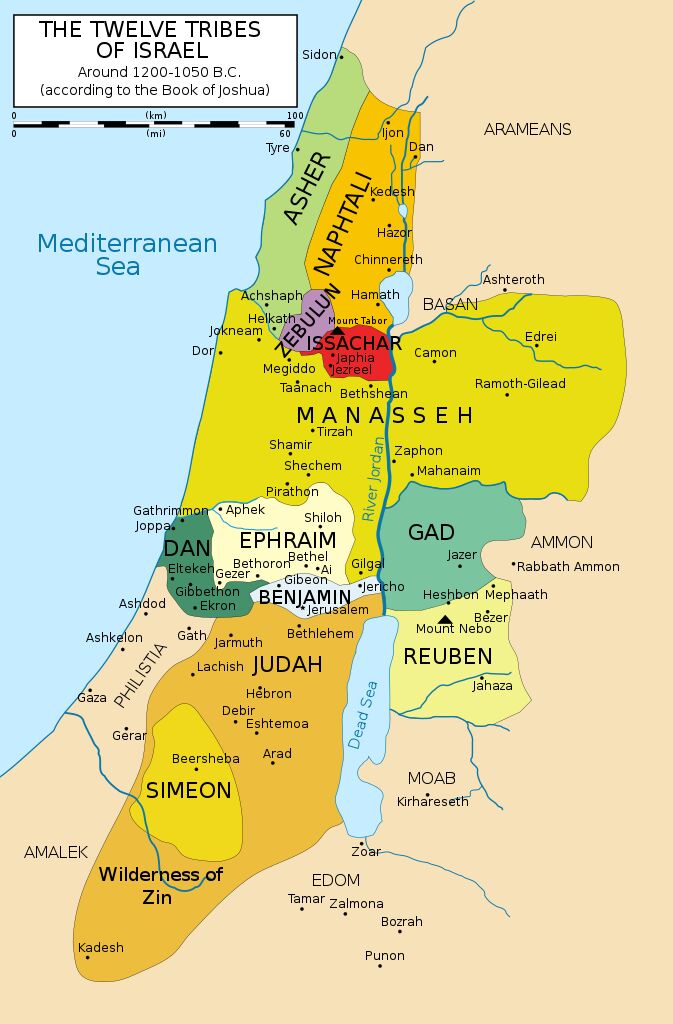
And there’s something unusual that archaeologists have discovered when it comes to Danite territory—it is replete with Greek influence. For example, remains from the “capital city” of the Danites, the northern territory of Tel Dan (identified on this map at the northern border of Naphtali), show heavy Greek-Mycenaean connection in household items, weaponry, burials, idolatry, etc. So much so, that Haaretz archaeology contributor Philippe Bohstrom wrote a (highly recommended) article on the subject titled “Tribe of Dan: Sons of Israel, or of Greek Mercenaries Hired by Egypt?”
This peculiar connection between the tribe of Dan and the Greek world has long been noticed by scholars, and is identified in several biblical passages. Ezekiel 26:19 attests to “Dan also and Javan [the biblical name for Greece] going to and fro” in sea trade (King James Version). And, a Judges account preceding the time of Samson condemns the tribe of Dan for not participating in an overthrow of Canaanite oppression because they were out “sojourning” in “ships” (Judges 5:17).

Coincidentally(?), the Greek poet Homer writes about a certain Mycenaean seafaring tribe out “in their ships” around this time that participated in the Battle of Troy—a people known as Danaoi (also named Danaan). These Danaoi—descendants of a patriarch named Danaus—have also been linked with a mysterious seafaring Levantine people known from various inscriptions as “Denyen.” The famous late Israeli archaeologist Prof. Yigael Yadin posited that these people were one and the same as the tribe of Dan.
Thus, could stories of the Danite strongman Samson have found their way into Greece by the seafaring tribe of Dan’s contact with the Mycenaean world? Perhaps via their merchant men, whose name in Hebrew is Haroclim—a word that some posit as the etymological origin for the Greek name Heracles? Or, perhaps, such stories could have been passed around the Mediterranean by the descendants of the Philistines, the neighboring tribe of Dan’s adversaries—themselves a seafaring Mediterranean polity connected with Greece.
The links go further afield—much further afield. Because according to ancient Irish folk histories, Ireland was settled by a people known as Tuatha de Danann, which can be translated as “Tribe of Danann” (compare, again, with Homer’s Danaan). The famous early-11th-century c.e. Irish text Lebor Gabála Érenn (“Book of the Taking of Ireland”) relates that this tribe of “Danann” had landed by ships in Ireland from the Mediterranean in the second millennium b.c.e. after having been in a constant state of war with the Philistines.
Sound familiar? Many of the folk legends surrounding the Tuatha de Danann are also uncannily similar in style to those of Greece and Hercules. (Could such a migration and early Irish connection with the Mediterranean explain why a royal Philistine seal ended up in Ireland?)

Added to all of this, is it just accident that the Israelite tribe of Dan—one of the most powerful, populous tribes (in fact, the second biggest by a good margin, as revealed in the book of Numbers censuses at the time of the Exodus)—all but disappears from the biblical record following the Exodus account, apart from a handful of token references (and at that, a majority of them unfavorable, highlighting their brutality and paganism)? What happened to this tribe? Where did they go?
Enter an intriguing connection to the Exodus, and a growing theory that a part of the Israelites, following the Exodus, settled in Greece—particularly, those of the tribe of Dan. Because here again, just as Samson was of the Danite tribe (Hebrew, a Dani), Hercules/Heracles himself was a Danaoi.
And the Danaoi, according to the classical Greek historians, fled into Greece out of Egypt.
An Exodus Out of Egypt—But to Where?
The fourth-century b.c.e. Greek historian Hecataeus of Abdera—the earliest-known historical source we have outside the Bible that goes into some detail about the Israelite exodus out of Egypt—writes the following about the Exodus in his work Aegyptiaca (emphasis added throughout):
When in ancient times a pestilence arose in Egypt, the common people ascribed their troubles to the workings of a divine agency …. At once, therefore, the aliens were driven from the country, and the most outstanding and active among them banded together and, as some say, were cast ashore in Greece and certain other regions; their leaders were notable men, chief among them being Danaus and Cadmus. But the greater number were driven into what is now called Judaea …. [This] colony was headed by a man called Moses, outstanding both for his widom and for his courage.
As Menahem Stern writes in his commentary on this text (within his larger publication Greek and Latin Authors on Jews and Judaism), “Hecataeus [in his writings] is devoid of anti-Semitic feelings, and his attitude to Jews is, if anything, sympathetic. In their expulsion from Egypt, the Jews are coupled with the emigrants to Greece, led by Cadmus and Danaus”—the patriarch of the Danaoi, father of what is known as the “Danaid dynasty” in Greece.

In Larry S. Milner’s lengthy book Was Achilles a Jew? Hebraic Contributions to Greek Civilization (a book intended to highlight the immense amount of evidence for a connection and common origin in the Greek and Hebrew worlds), he writes similarly about Danaus:
Another popular legend about the foundation of Mycenae, which is even more suggestive of an arrival of a group of Hebrew dissidents following the Exodus, is the myth that claimed the Mycenaeans descended from Danaus, who fled Egypt with his fifty daughters and traveled to the Greek mainland, reaching Lerna in Argos via the island of Rhodes. … Danaus then became the king of Argos, and his descendants became known as the Danaoi, or Danaans, one of the terms Homer used to refer to the Greeks in the Iliad.
Like the story of the Trojan War, the legend of Danaus was accepted by most ancient historians as being based on factual historical events …. According to Manetho [the third-century b.c.e. Egyptian priest-historian], Danaus … was exiled during the Eighteenth Dynasty, and he fled for refuge to the land of the Greeks, where he then ruled as the king of Argos.
Interestingly, this is the very same time frame for the Exodus given by Bible chronology—during Egypt’s 18th Dynasty. But the early historians get more specific. Milner continues:
Hecataeus of Abdera (c. 320 b.c.e.), the Greek historian and Sceptic philosopher who rose to fame under King Alexander … was the first ancient author to claim that the Exodus took place during the time of Danaus …. Hecataeus did not supply a chronological framework for these events, but subsequent authors—such as the Egyptian historian Charemon (first century c.e.), the Egyptian priest Ptolemy of Mendes (first century c.e.), and the Roman historian Tacitus (c. 55-117 c.e.)—provided estimates, which would place the event in the fifteenth century b.c.e. … Other sources dated the arrival of Danaus … to c. 1430 b.c.e. (pp. 308-311, 315)
Again, this matches with biblical chronology, which points to an Exodus during the 15th century b.c.e., and even more specifically, during the last half of that century—around 1450–1410 b.c.e. (see here for more detail).
Could that be why, in the early third century b.c.e., the Spartan king Areus i sent a letter to the Jewish ruler Onias i, stating (rather jaw-droppingly): “We have met with a certain writing, whereby we have discovered that both the Jews and the Lacedemonians [Spartans] are of one stock and are derived from the kindred of Abraham. It is but just therefore that you, who are our brethren, should send to us about any of your concerns as you please …”?
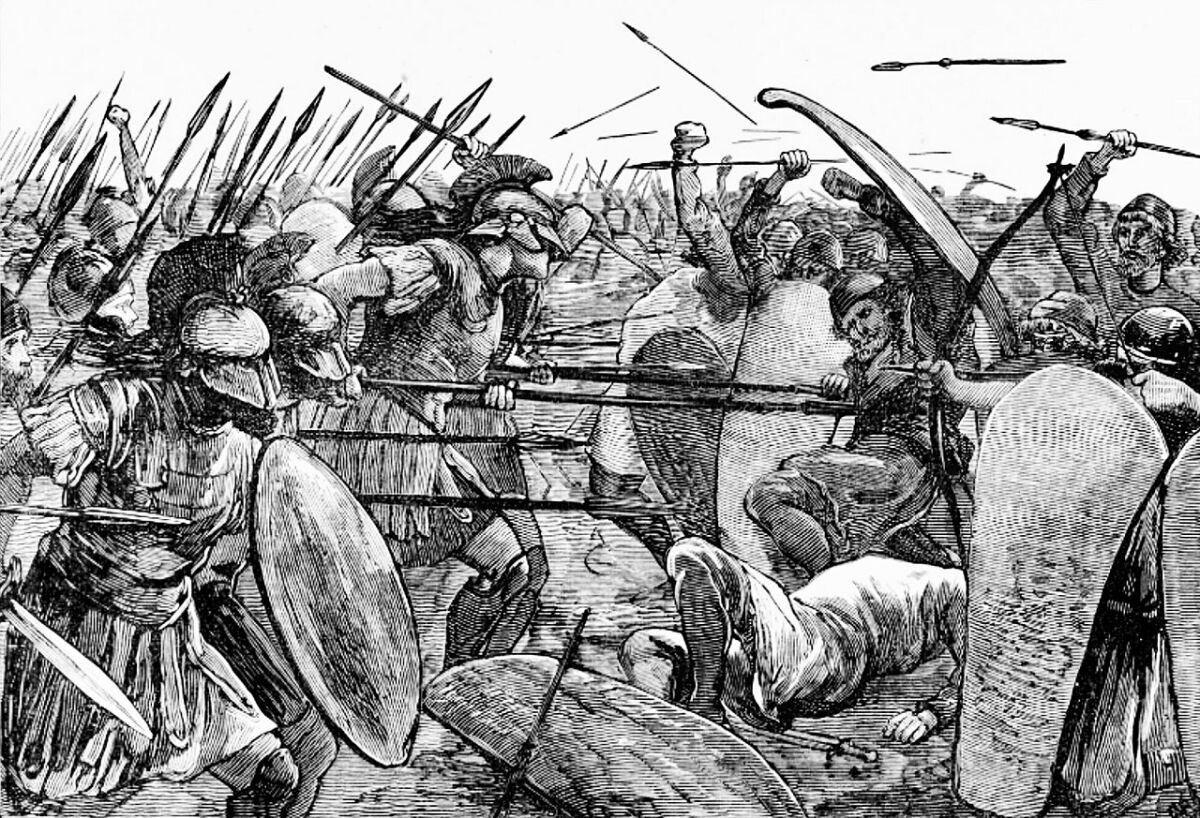
Thus (depending on the chronology), we have the Danaid dynasty established in Argos (sometimes called the Argive dynasty) at the end of the 15th and start of the 14th century b.c.e. We can extrapolate this timeline further. Hercules in ancestry is seven generations removed from this Greek “Exodus” of Danaus and his daughters (Danaus-Hypermnestra-Abas-Acrisius-Danae-Perseus-Electryon-Alcmene-Heracles). Based on the above chronologies, this would logically put him on the scene somewhere around the 12th to 11th centuries b.c.e.—roughly the same time period as the Danite Samson.

Again, together with the “deeds” of these strongmen, is this all mere coincidence?
History’s Greatest Plagiarists?
The thing is, Greece’s dramatic “reproduction” of suspiciously familiar-sounding accounts is not limited to Samson-Hercules. Other examples abound.
How about an earlier account from the book of Judges, again mentioning the overthrow of a band of Philistines? “And after him was Shamgar the son of Anath, who smote of the Philistines six hundred men with an oxgoad; and he also saved Israel” (Judges 3:31). This single-verse, 18-Hebrew-word account, set somewhere around the 13th century b.c.e., is paralleled by a later eighth-century b.c.e. Greek myth telling of an event in the distant past in which the northern leader of Thrace, Lycurgus, used an oxgoad to strike down an army of Bacchus in defense of holy territory. Depending on which source you follow (and thus, the geographical placement of this battle), this oxgoad event took place in the Holy Land, near Mount Carmel, “a mountain in Judea, which makes it probable that this is hammered out of the [same] sacred history” (Gill’s Exposition of the Entire Bible).
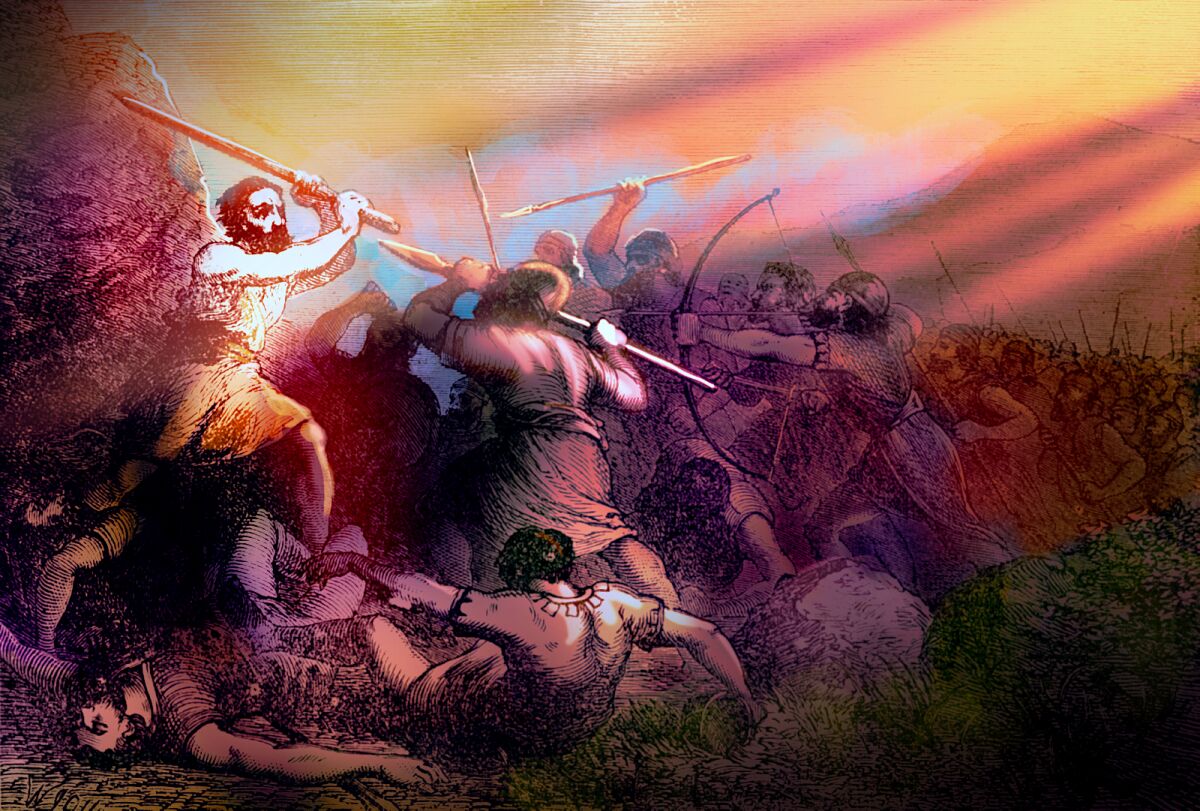

What about another, more visual example? You’ve likely seen the medical symbol of a serpent wrapped around a pole, perhaps plastered on the side of an ambulance or a hospital, or as displayed by the World Health Organization (their official symbol, right). This snake-entwined staff symbol is known as the “Rod of Asclepius.” It is usually traced back to the Greek god of healing, Asclepius, who is mentioned by Homer in the Iliad, and whose cult developed especially from the sixth century b.c.e. onward. Depictions (such as the one below) generally show this god holding a rod with a snake coiled around it. Different theories have been given for the meaning of this symbol, such as the snake shedding its skin as a symbol of regeneration or healing.
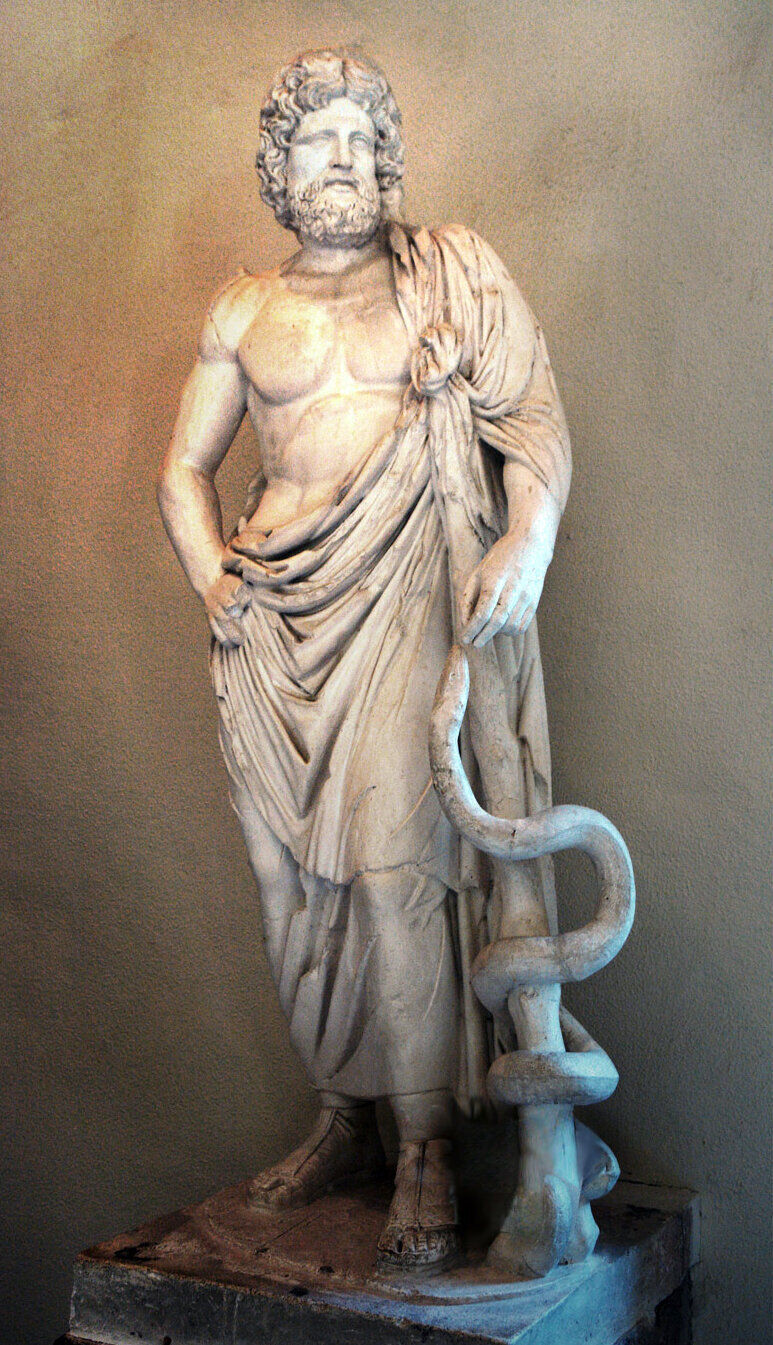
But a snake-wrapped rod of “healing” goes back even further—again to the Exodus, as described in Numbers 21. In this account, the Israelites had become “impatient” with the long route and began blaspheming God and condemning Moses. Verse 6 reads: “And the Lord sent fiery serpents among the people, and they bit the people; and much people of Israel died.” The terrified Israelites begged for mercy, and Moses prayed on their behalf. God then gave Moses a peculiar set of instructions (verses 8-9):
And the Lord said unto Moses: “Make thee a fiery serpent, and set it upon a pole; and it shall come to pass, that every one that is bitten, when he seeth it, shall live.” And Moses made a serpent of brass, and set it upon the pole; and it came to pass, that if a serpent had bitten any man, when he looked unto the serpent of brass, he lived.

The Bible relates that this snake-entwined bronze pole, which the Israelites brought with them into the Promised Land, became such an item of pagan worship that the later King Hezekiah had it destroyed (2 Kings 18:3-4).
Could this have been the inspiration for the Rod of Asclepius? Several researchers think so, and this story is generally given when discussing the origins of the Rod of Asclepius. A serpent wrapped around a rod, related specifically and directly to healing and eventual pagan worship—surely this is more than coincidence?
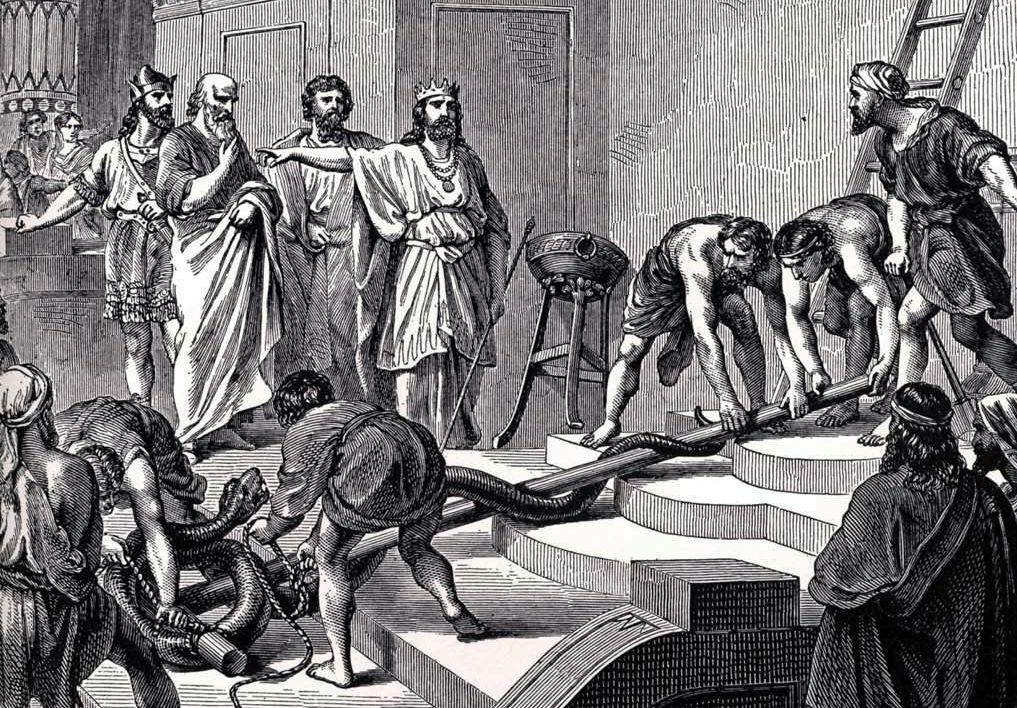
Sparta’s 300 is also rather uncanny. The band of 300 Spartan warriors is generally recognized as authentic (though they were supported by several thousand uncredited backup troops). But where did Sparta’s idea to have a core band of 300 warriors even come from? Is its parallel to the biblical account of Gideon’s 300, just prior to the time of Samson, just coincidence? And what about centuries further back, Abraham’s 300 (or, to be more precise, 318)? After all, in the words of the Spartan king, his people were “derived from the kindred of Abraham.”
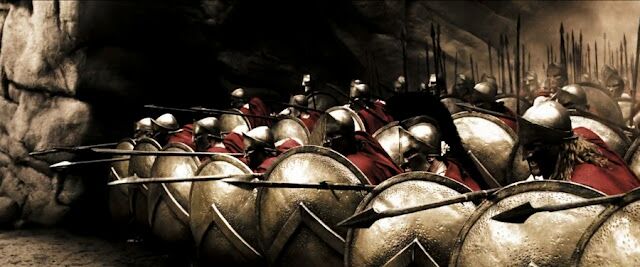
The list could go on. Numerous Greek stories parallel biblical accounts: mother Eve and Gaia; Cain and Kronos; Tuvalcain and the Greek Vulcan/Hephaestus; Noah’s ark and Deucalion’s ark; the baby Moses’ “ark of bulrushes” and its own parallel Greek birth legends.
A Genuine Core to Samson/Hercules—But First in Greece? Or Israel?
But is it possible to know, from an entirely sceptical position, which could have come first—the Hebrew accounting of Samson, or the Greek story of Hercules? Which was dependant on the other? As stated above, even the manner in which the accounts are told—the more simple, straightforward and “realistic” Hebrew versus the over-extrapolated, “fantastical” Greek—favors the primacy of the former, in reflecting the original true historical core.
When it comes to Hercules/Heracles, the earliest writings that attest to him are those of Homer, usually dated to the eighth century b.c.e. The writing of the Judges account is traditionally attributed to the 11th-century b.c.e. prophet Samuel (and indeed, as explained by Craig Davis in Dating the Old Testament, the books attributed to Samuel consist of some of the most archaic forms found in the Hebrew Bible, besides the Torah).

Still, the sceptic will point out that the earliest extant work that we actually have relaying such texts is contained in the third- to second-century b.c.e. Septuagint Greek translation and the second- to first-century b.c.e. Dead Sea Scrolls. Then again, by the same token, the earliest surviving manuscript for Homer dates to about 400 years later than his cited date of composition.
At the time in which the first-century c.e. Jewish historian Josephus was on the scene, he addressed (rather cynically) the Greek-nationalistic charge at the time that the Greek histories bore the greater antiquity and were the work of greater historians:
[A]lmost all which concerns the Greeks happened not long ago; nay, one may say, it is of yesterday only. I speak of the building of their cities, the inventions of their arts, and the description of their laws; and as for their care about the writing down of their histories, it is very near the last thing they set about. … However, there is not any writing which the Greeks agree to be genuine among them ancienter than Homer’s [eighth-century b.c.e.] Poems …. Nay, the report goes, that even he did not leave his poems in writing, but that their memory was preserved in songs, and they were put together afterward, and that this is the reason of such a number of variations as are found in them.
We therefore (who are Jews) must yield to the Grecian writers as to language and eloquence of composition; but then we shall give them no such preference as to the verity of ancient history, and least of all as to that part which concerns the affairs of our own several countries. (Against Apion, 1.2, 5)

Josephus proceeded to explain just why he believed the Jewish historical accounts should take precedence of authenticity and antiquity over the Greek:
[H]ow firmly we have given credit to these books of our own nation is evident by what we do. For during so many ages as have already passed, no one has been so bold as either to add any thing to them, to take any thing from them, or to make any change in them [Deuteronomy 4:2, 12:32, etc. outlines the curses involved in doing so]; but it is become natural to all Jews immediately, and from their very birth, to esteem these books to contain Divine doctrines, and to persist in them, and, if occasion be willingly to die for them. For it is no new thing for our captives, many of them in number, and frequently in time, to be seen to endure racks and deaths of all kinds upon the theatres, that they may not be obliged to say one word against our laws and the records that contain them; whereas there are none at all among the Greeks who would undergo the least harm on that account, no, nor in case all the writings that are among them were to be destroyed. (1.8)
It’s a good point—who among the Greek world would be willing to die to uphold the veracity of their fantastical and variously conflicting histories? Josephus concluded this section with a thinly veiled stab at the fifth-century b.c.e. Greek historian Herodotus:
[S]ome persons have written histories, and published them, without having been in the places concerned, or having been near them when the actions were done; but these men put a few things together by hearsay, and insolently abuse the world, and call these writings by the name of Histories. (ibid)
But in establishing historicity, this is where archaeology comes into its own.
Archaeology and Samson
Naturally, while the biblical Samson account clearly hinges on a realistic worldview (as opposed to that of Hercules), many will still regard it as unbelievable. That’s fine. But a rather remarkable confluence of archaeological evidence has emerged supporting the setting and even certain specific details of the Hebrew account.
The presence of the Philistines and Israel’s struggles against them during this time period have been clearly shown through archaeology. In fact, it is interesting that it is only really from the biblical time period of Samson (12th–11th centuries b.c.e.) onward that the Philistines are described as becoming a problem for judges-period Israel—because it is during this very time period that evidence shows the majority of the Philistines migrated to the Levant.

Added to that, several of the biblical Philistine cities have been discovered, showing evidence of occupation during these time periods. Inscriptions have been discovered corroborating biblical Philistine names. Recent dna evidence has also shown that the Philistines arrived from Crete—something the Bible repeatedly affirms, but which many scholars had long dismissed, positing other locations of origin. The worship of the Philistine god Dagon during the second millennium b.c.e. is also attested to in inscriptions.
The act of blinding Samson then putting him to backbreaking labor in a mill has been attested to in Hittite archaeology—and the Hittites were defeated by the Sea Peoples (of whom the Philistines made up a significant part) during the late second millennium b.c.e. Thus, it would not have been surprising for the barbaric Philistines to have adopted such a punishment.
And Samson’s final act of pushing apart two central pillars holding up a Philistine temple, thereby killing the revelers around him (along with himself), has actually also been substantiated through archaeology. It has been shown at several sites that Philistine temples were indeed supported by twin central pillars, situated just far enough apart to stretch a large man’s arms between them.

Of course, any absolute archaeological proof of the man himself is naturally going to be elusive. But perhaps the most intriguing discovery of all, hinting at the most iconic image of the larger-than-life Hercules and Samson, is the very smallest: a tiny stone seal stamp, dating to sometime around the 12th century b.c.e., found at Beth Shemesh—a site not far from Samson’s first feat of superhuman strength.
The otherwise unassuming, simple engraving depicts a man fighting a lion with his bare hands.

